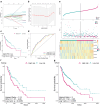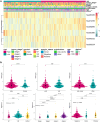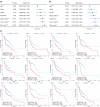A transcriptional metabolic gene-set based prognostic signature is associated with clinical and mutational features in head and neck squamous cell carcinoma
- PMID: 32067104
- PMCID: PMC11804320
- DOI: 10.1007/s00432-020-03155-4
A transcriptional metabolic gene-set based prognostic signature is associated with clinical and mutational features in head and neck squamous cell carcinoma
Abstract
Purpose: Head and neck squamous cell carcinoma (HNSCC) is a common cancer with high mortality and poor prognosis partially owing to lack of application of predictive markers. Increasing evidence has suggested that metabolic dysregulation plays an important part in tumorigenesis. We aim to identify a prognostic metabolic pathway (MP) signature in HNSCC.
Methods: Single sample gene-set enrichment analysis (ssGSEA) was used in metabolic gene sets to develop a metabolism-based prognostic risk score (MPRS) for HNSCC using Cox regression analysis (univariate, LASSO, and stepwise multiple cox analysis), which was then validated in different subgroups, and association with clinical and mutational features was analyzed.
Results: Seventy-two dysregulated metabolic pathways were identified, and a six-MP signature (6MPS) was constructed which can effectively distinguish between the high- and low-risk patients in both training and testing sets, accompanied with high sensitivity and specificity (AUC = 0.7) in prognosis prediction. 6MPS was also applicable to patients of different subgroups. Furthermore, 6MPS is not only an independent prognostic predictor but also associated with clinicopathological and mutational features. Higher tumor stage and tumor mutation burden (TMB) have a higher MPRS.
Conclusion: 6MPS functions not only as a promising predictor of prognosis and survival but also as potential marker for therapeutic schedule monitoring.
Keywords: Biomarker; Head and neck squamous cell carcinoma; Metabolic pathway; Prognosis; Survival.
Conflict of interest statement
The authors declare that they have no conflict of interest.
Figures




References
-
- Aboud OA, Weiss RH (2013) New opportunities from the cancer metabolome. Clin Chem 59:138–146. 10.1373/clinchem.2012.184598 - PubMed
-
- Ballman KV (2015) Biomarker: predictive or prognostic? J Clin Oncol 33:3968–3971. 10.1200/JCO.2015.63.3651 - PubMed
-
- Buck A, Aichler M, Huber K, Walch A (2017) Situ metabolomics in cancer by mass spectrometry imaging. Adv Cancer Res 134:117–132. 10.1016/bs.acr.2016.11.004 - PubMed
-
- Budach V, Tinhofer I (2019) Novel prognostic clinical factors and biomarkers for outcome prediction in head and neck cancer: a systematic review. Lancet Oncol 20:e313–e326. 10.1016/S1470-2045(19)30177-9 - PubMed
MeSH terms
Substances
LinkOut - more resources
Full Text Sources

